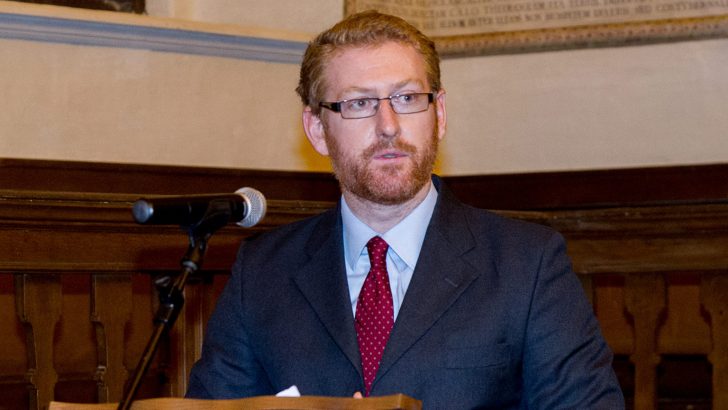Personal Profile
When Dr Alex O’Hara visited Clonmacnoise as an eleven-year-old, he could hardly have known that it would be a life-defining moment. But looking back now, the professor of early Church history and Irish monasticism knows that this visit and another to a monastery in Normandy had a “profound effect” on him.
Dr O’Hara’s faith was nourished from a young age by his mother and grandmothers, after his father died when he was two-years-old.
Another aspect of his young life that was to have a lasting effect was visits he paid as a young boy to ancient Christian sites connected with Irish monastics”
“I would say my faith was really transmitted through my mother and grandmothers from a young age,” Dr O’Hara explains, “the women in my family. My father died when I was two – I remember being at another funeral when I was six and seeing a dead body for the first time – at that age, you begin to wonder. I think that experience of death at a young age had an impact.”
As well as the faith that was passed on to him by his mother, Dr O’Hara says he was lucky to have a number of good religion teachers in school: “I was very lucky in primary school in Galway to have two fantastic religion teachers. A laywoman called Miriam Costello and Dara Mannion… And then I was an altar boy for a while and there was one particular priest in Dublin who was a very dynamic and young priest, and he had a positive influence on me.”
Another aspect of his young life that was to have a lasting effect was visits he paid as a young boy to ancient Christian sites connected with Irish monastics.
“I always had an interest in monastic sites,” Dr O’Hara remembers. “It was because my mother brought me to Clonmacnoise for my birthday and stuff like that… I think places like Clonmacnoise, Glendalough, they really had an influence on me. There was a sense of what TS Elliot would call ‘where prayer has been valid’. There was still a sense of peace, of tranquillity, and just the deep richness of the Faith in these places.
Remarkable
“When I was nine, we did a trip – it was organised through the Friends of St Brendan and The Irish Times – to Normandy. It was 1989, so the centenary of the French Revolution, and we visited a lot of the monasteries in the north of France associated with the Irish. It was really remarkable.
“Jung would call it synchronicity or whatever, the Holy Spirit really, but later on when I was working on my book for Oxford University Press on Jonas of Bobbio, biographer of St Columbanus, I went to stay in Saint Wandrille in Normandy for a few days when I was researching the book on Jonas, and there was a deja vu moment where I went, I’ve been here before.
“I came as an nine-year-old and it was my first experience of Gregorian chant, in the Benedictine community, and at the time it had a profound impact on me as a young boy. I remember crying after hearing the monks. There was something sad and very beautiful about the chant. I asked my mother who are these strange men with their funny haircuts and dressed in black. I found it really bizarre. But something about the beauty of the chant struck me. And then in 2013, I ended up going back there as a historian, it was incredible really.”
Between the two trips, Dr O’Hara’s life had begun to take shape. He studied in St Andrew’s University, Scotland, where at the chaplaincy – for which he eventually served as warden – he found a “vibrant Catholic community”. It was also here that he began to study medieval history under the well-known English Medievalist Robert Bartlett, and on his holidays he went to a Benedictine abbey for retreats.
After a year in Oxford, he returned to St Andrews to do a PhD on the biographer of St Columbanus: “I ended up going to Vienna then after my PhD. I worked in the Austrian Academy of Sciences, but I had felt the pull to monastic life from my mid-20s. Once I had finished up my academic projects in Vienna, I was 34 at the time, I decided to go back to Ireland. I always wanted to return.
“I came back in 2016, having been away for 16 years. I returned to enter Glenstal Abbey as a Benedictine monk, from October 2016. I completed the novitiate, the one-year novitiate, and I took simple vows, before deciding to leave in 2018.
Someone reached out to me last summer and asked me if I would I like to apply for this role as national director for catechetics”
“Again, that was a very important experience. It certainly deepened my faith, I’m still friends with many of the community there. That was quite tough once I’d made that decision to leave. It was a big decision going in and a big decision leaving.”
Afterwards he worked for the Loyola Institute in Trinity University, lecturing and continuing his research. This year, he organised a series of online lectures to mark the 1500th anniversary of St Columba of Jonás birth. Now, however, he is beginning a new chapter of his life as national director for catechetics for the Irish bishops’ conference, responsible for coordinating Catholic religious education and faith formation on behalf of the Council for Catechetics.
“Someone reached out to me last summer and asked me if I would I like to apply for this role as national director for catechetics. I wasn’t aware of the role at the time. I said yeah sure, and that’s it basically. I finished up my work with the Loyola Institute and began my current appointment as national director. I’m very excited by it… I’m also quite hopeful.”


 Alexander O'Hara
Alexander O'Hara